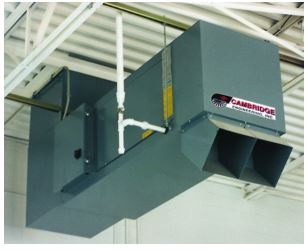As the weather changes to cooler temperatures, the operating routine for your ventilation system should also change. Here are some tips from the Eldridge ventilation experts for operating a ventilation system in cooler weather.
 Replace Heaters
Replace Heaters
The first priority for a ventilation system in cooler temperatures is to provide heat. This can be expensive with rising energy costs. Consider upgrading to energy efficient high temperature heating & ventilation system (HTHV) technology. Heaters with HTHV technology can reduce heating costs by 20%. We recommend the Cambridge Air Solution HTHV heaters which have the lowest total cost of ownership when compared to other heaters. Now is the time to order and have them installed before the really cold weather hits.
Run Heaters Now
Fall weather brings warm days and cool nights. In these conditions, equipment, building and floor surfaces will sweat when the nighttime temperature drops below the dew point. To prevent moisture condensation, turn on heaters at night to keep the temperature above the dew point.
Provide Fresh Air
The second priority for a ventilation system in cooler temperatures is to provide fresh air. Turning off fans and closing building openings will trap inside dust, fumes and smoke generated by operating activities. We recommend running at least one fan to maintain a steady flow of fresh air. That will also reduce the humidity and the chance of condensation. With one or more fans running, remember to also open louvers or doors to prevent an unsafe pressure build-up.
 Leave HVLS Fans On
Leave HVLS Fans On
HVLS fans are a great dual benefit piece of ventilation equipment. In hot temperatures, they provide comfort cooling by moving a large volume of air across people. In cooler temperatures, they can be used to move warmer air from the top of the building to the floor area. Just make sure to turn the fan speed down.
Close Backdraft Dampers
Backdraft dampers should be closed to minimize cold air infiltration and reduce heating costs. Fix or replace dampers that don’t fully close or that are missing blades.
Conclusion
I hope that these tips will help you develop best practices for operating a ventilation system in weather. Creating a successful environment in your facility year-round requires having the right ventilation equipment and knowing how to adjust the system according to the outside weather conditions.
